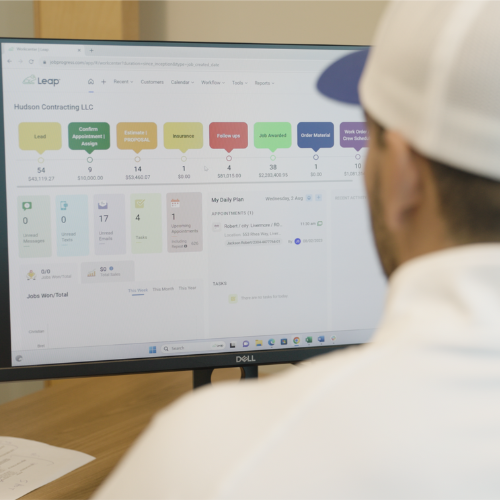Construction projects are a complex process of planning, design, execution, and management. It’s a dynamic field that requires precision, coordination, and collaboration from various stakeholders. Despite careful planning, common issues in construction projects can emerge.
These issues can often lead to delays, cost overruns, and sometimes even legal disputes. Therefore, recognizing these issues and continuously improving your business practices is crucial for ensuring success.
Let’s explore some of the most frequent and costly mistakes and issues encountered in construction projects. In addition, we’ll discuss the many ways you can prevent these mistakes before they ever become a major problem within your business.

Do You Know the Most Common Issues in Construction Projects?
The first step to any problem is recognizing you have one. And in many cases, construction companies ignore these issues as a “part of the job” that comes along with the work. However, this is the quickest way to develop a bad reputation, lose out on future projects, and ultimately lose your business.
That’s why it’s so important to recognize problems the industry is facing. In fact, this can have a huge impact on your success or failure. For example, the most common issues in construction projects include:
- Document management
- Miscommunication
- Scope creep
- Risk management
- Quality control
- Resource management
- Safety measures
- Contingency planning
As you can see, there’s a long list of problems that can make or break a construction job. And in general, even the most successful companies must overcome these issues from one project to the next.
Let’s dig deeper into these problems and address how you can mitigate the risks. With the right systems and processes in place, you can shore up your construction workflow and management to become more efficient and effective.
1. Poor Document Management
One of the most common issues in construction projects is poor document management. Proper documentation is the backbone of any construction project, ensuring that everyone is on the same page. It also helps you track progress accurately.
However, many projects suffer due to inadequate document management systems, which can lead to various problems:
- Lost or Misplaced Documents: When important project documents, such as blueprints, contracts, or permits, go missing, it can disrupt the project timeline and lead to costly delays.
- Version Control Issues: Without a robust system for version control, different team members may be working with outdated plans or specifications, causing conflicts and rework.
- Inefficient Retrieval: If project documents are not organized and easily accessible, project team members may waste valuable time searching for the information they need.
- Legal and Regulatory Non-Compliance: Inadequate document management can lead to non-compliance with legal and regulatory requirements, which can result in costly fines or project shutdowns.
To mitigate these document management issues, construction companies should invest in CRM systems and management software that provides documentation features. This includes proposals, contracts, version control, and proper organization of project-related files. Moreover, regular training and communication among team members can also help ensure that everyone knows how to use these systems effectively.
2. Miscommunication
Effective communication is the cornerstone of a successful construction project. Miscommunication can lead to a cascade of issues, affecting everything from project scope to safety. Here are some common miscommunication issues in construction projects:
- Ambiguity in Project Requirements: Unclear project requirements can lead to misunderstandings and discrepancies in the work to be performed.
- Lack of Timely Updates: Failing to keep stakeholders informed about project progress and changes can result in dissatisfaction and mistrust.
- Poor Coordination: When different teams and subcontractors are not effectively coordinated, it can lead to bottlenecks and delays in project execution.
- Safety Risks: Miscommunication about safety protocols can result in accidents and injuries on the construction site.
To address miscommunication issues, construction companies should establish clear communication protocols. Conduct regular project status meetings and encourage open lines of communication among all stakeholders.
Using collaboration tools and CRM software can help streamline communication processes. This also ensures that all parties have access to up-to-date project information.
3. Scope Creep
Scope creep is a subtle but prevalent issue in construction. Specifically, it refers to the gradual expansion of project scope beyond the initial plan without proper documentation and approval. Scope creep can lead to:
- Budget Overruns: Additional work not accounted for in the budget can lead to increased costs and financial strain.
- Delays: Expanding the scope without extending the timeline can lead to project delays.
- Disputes: Unapproved scope changes can result in conflicts between project stakeholders, including clients and contractors.
Scope creep is easily one of the most common issues in construction projects right now. Yet, you can avoid scope creep by having a well-defined project scope from the outset.
Any proposed changes should be thoroughly documented and assessed for their impact on the project’s timeline and budget. Furthermore, all changes should be approved by all relevant parties. Clear management processes can help streamline scope changes effectively.
4. Inadequate Risk Management
Construction projects are inherently risky. Consequently, failing to identify and address these risks can lead to significant issues.
Common risks include unforeseen site conditions, supply chain disruptions, weather-related delays, and labor shortages. Overall, inadequate risk management can result in:
- Increased Costs: Unmitigated risks can lead to cost overruns as the project encounters unexpected obstacles.
- Delays: Managing risks poorly can cause delays in the project schedule.
- Safety Concerns: Ignoring potential safety risks can lead to accidents and injuries on the construction site.
To address risk management issues, construction companies should conduct thorough risk assessments at the project’s initiation. Developing risk mitigation plans, allocating appropriate resources, and regularly monitoring and adjusting these plans can help minimize the impact of unforeseen events.
5. Quality Control Problems
Maintaining high-quality construction standards is crucial for the longevity and safety of the built structure. Common issues in construction projects concerning quality control include:
- Poor Workmanship: Shoddy workmanship can lead to structural issues, maintenance problems, and, in extreme cases, safety hazards.
- Insufficient Inspections: Failing to conduct thorough inspections and quality checks can result in subpar construction or defects.
- Material Quality: The use of substandard or counterfeit materials can compromise the quality of the project.
- Lack of Documentation: Incomplete or inaccurate documentation can make it challenging to track the quality of work and materials used.
To address quality control problems, construction companies should establish robust processes, implement regular inspections, and maintain a culture of accountability and pride in the work performed. Keeping detailed records of material and work quality is essential to ensure compliance with standards and regulations.
6. Resource Management
Effective resource management is a critical aspect of construction projects. This includes managing labor, equipment, and materials efficiently. Common issues in resource management include:
- Resource Allocation: Allocating too many resources to a specific task can lead to resource shortages in other areas, causing delays and inefficiencies. On the flip side, insufficient resources can slow down project progress and lead to missed deadlines.
- Inadequate Inventory Control: Poor control over material inventory can result in wasted resources, as well as increased costs and delays.
- Unplanned Downtime: Inefficient use of equipment and labor can lead to unnecessary downtime and lost productivity.
Effective resource management involves careful planning, tracking, and optimizing resource allocation. Utilizing construction management software can help streamline these processes. Furthermore, software provides real-time visibility into resource allocation and usage.
7. Inadequate Safety Measures
Safety is always a primary concern in construction. Failing to prioritize it can lead to accidents, injuries, and even fatalities. A few of the common issues in construction projects to consider include:
- Lack of Proper Training: Inadequate training can result in unsafe practices and accidents.
- Insufficient Safety Protocols: Not having clear and enforced safety protocols can lead to hazardous conditions on the construction site.
- Ignoring Regulations: Non-compliance with safety regulations can result in fines, shutdowns, and legal issues.
- Inadequate Equipment: Failing to provide and enforce the use of necessary safety equipment can jeopardize a worker’s well-being.
To address safety issues, construction companies should invest in comprehensive safety training for their employees. It’s also important to enforce strict safety protocols, regularly conduct safety inspections, and ensure compliance with local and national regulations. Safety should be a top priority at all times.
8. Lack of Contingency Planning
Construction projects are subject to a wide range of uncertainties, from adverse weather conditions to unforeseen delays. Having a lack of contingency planning can lead to the following issues:
- Cost Overruns: Without contingency plans, unexpected costs can strain the project budget.
- Customer Dissatisfaction: Failing to manage contingencies properly can lead to customer dissatisfaction and potential legal disputes.
Effective contingency planning involves identifying potential risks and developing response strategies. This can include setting aside contingency budgets, creating alternative work schedules, and maintaining open communication with customers about potential project hiccups.
Overcome Construction Issues with Leap
Construction projects are a complex and demanding undertaking, and the potential for issues to arise is ever-present. Recognizing and addressing these issues is crucial for the success of any construction business.
That’s why the industry is turning to new technology and residential construction estimating software to clean up their inefficiencies. With Leap, you get an end-to-end management platform that centralizes all your documentation, automates your workflow, and streamlines your project management. In addition, Leap’s partner integrations are built to further enhance your operations from the sales process to job completion.
If you have a small construction business that’s looking to better manage each project, turning to software can transform the way you work. In an industry where success often hinges on the ability to navigate complexity and uncertainty, continuous improvement is essential. To learn how Leap can make a difference, fill out the form below and schedule a quick demo. Don’t let the most common issues in construction projects affect your business any longer.




